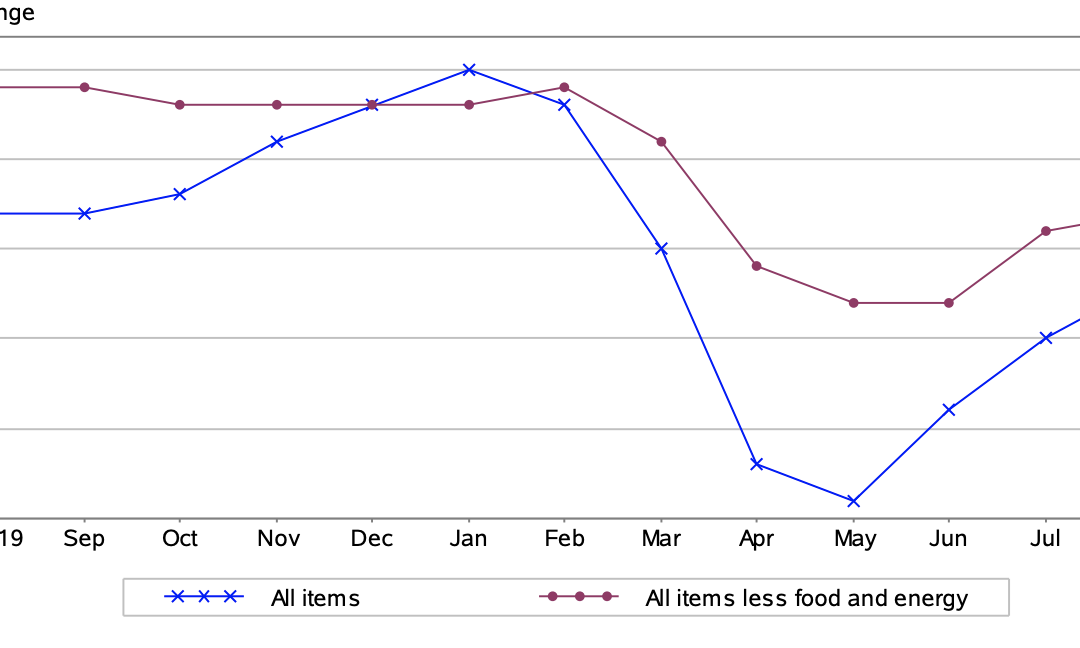
by Sarah Bauder | Sep 11, 2020 | CPI
The Consumer Price Index for All Urban Consumers (CPI-U) edged up 0.4% on a seasonally adjusted basis, reported the US Bureau of Labor Statistics. This is a slight decrease from the 0.6% rise seen in July.
Before seasonal adjustment, the all items index increased by 1.3%, over the past 12 month period.
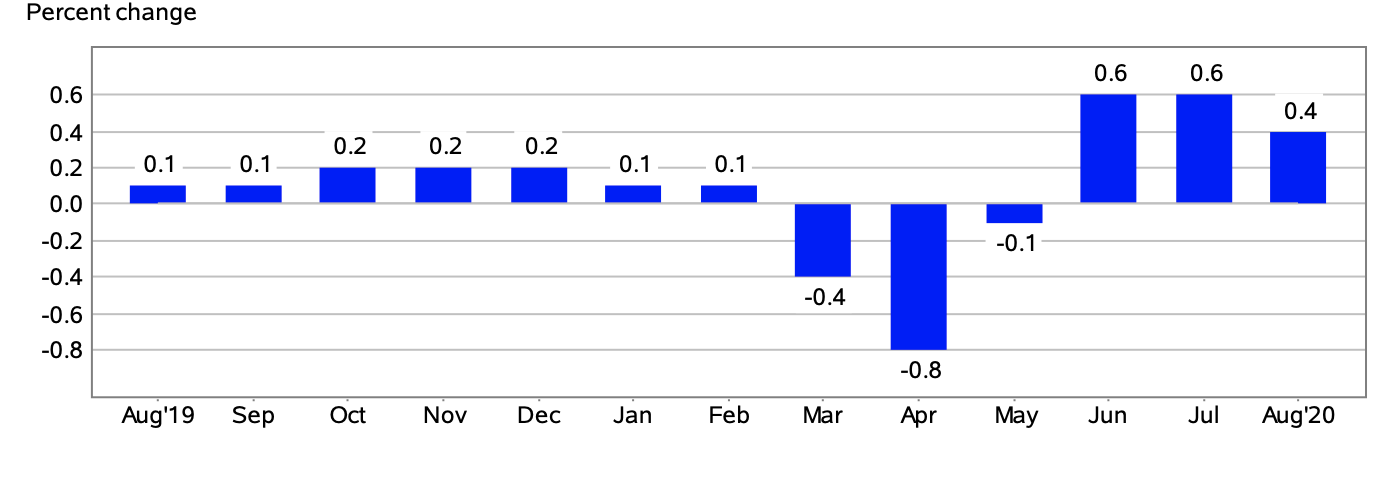
(Source: US Bureau of Labor Statistics)
Food Index
The index for food increased 0.1% in August, after seeing a 0.4% drop in July, reported the Bureau of Labor Statistics. The food at home index saw a slight decline of 0.1%. “The August decline was mostly caused by the index for meats, poultry, fish, and eggs, which fell 1.7% in August, its second consecutive monthly decline after sharp increases in prior months,” explained the bureau. Conversely, the food away from home rose 0.3% in August.
Over the last 12-months, the index for food at home edged up 4.6%. The index for meats, poultry, fish, and eggs 7.1% since this time last year. The food away from home index increased 3.5% over the past 12 months.
Energy Index
In August, the energy index increased by 0.9%, marking the third consecutive monthly percentage rise. The price of gasoline rose 2%, while both the electricity and natural gas indexes dropped 0.2%.
Over the last 12-month period, the energy index dropped 9%. The price of gas has plummeted 16.8%, as has the fuel oil index by 23.6% over the past year. In addition, the index for natural gas and electricity index both declined by 0.5% and 0.1%, respectively.
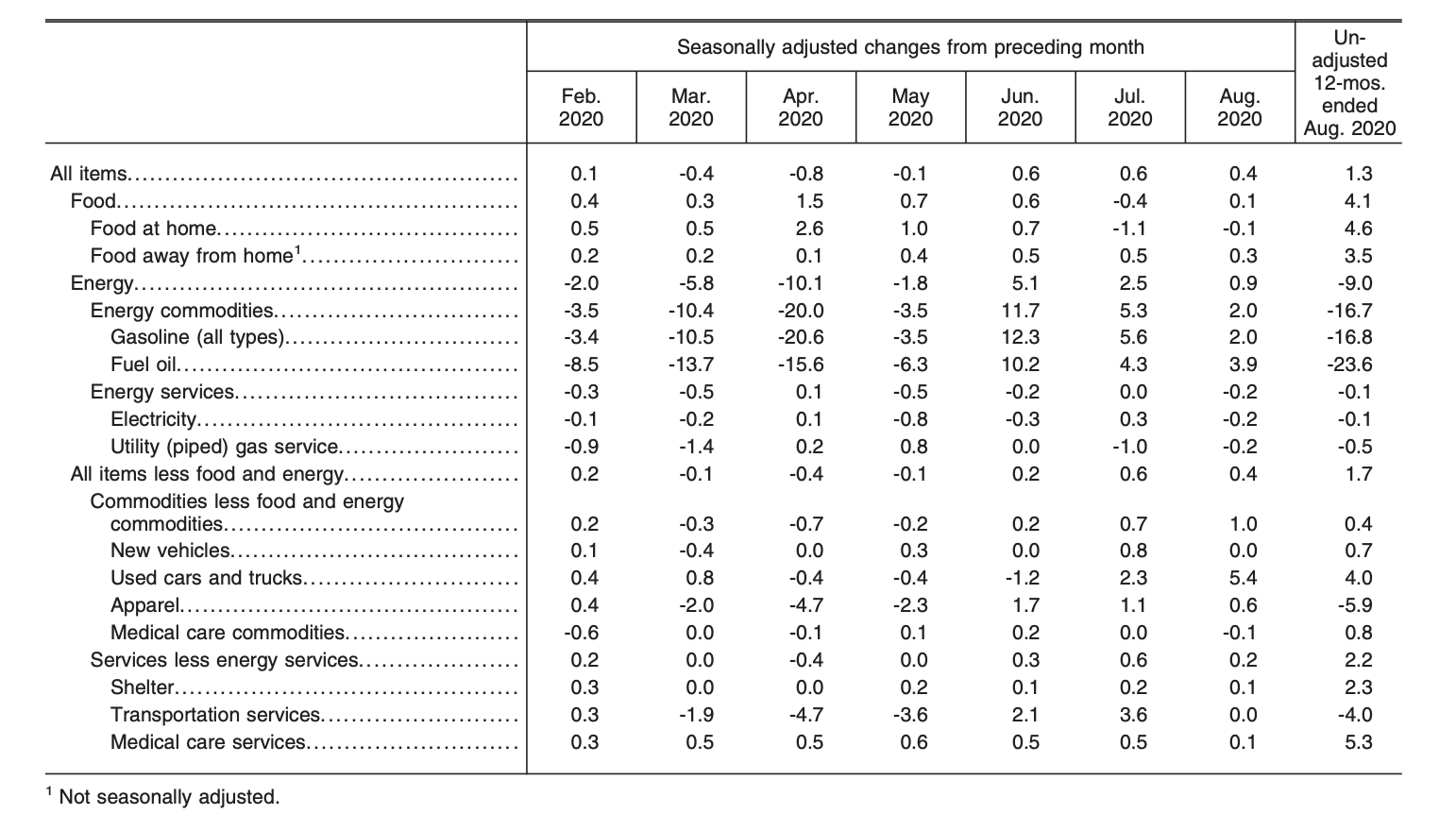
(Source: US Bureau of Labor Statistics)
All Items Less Food and Energy Index
In August, the all items less food and energy index rose 0.4%. This was primarily due to the used cars and trucks index. “The index for used cars and trucks increased 5.4% in August, its largest monthly increase since March 1969,” reported the Bureau of Labor Statistics. Several of the component indexes all saw slight percentage increases for the month including the shelter index by 0.1%, the medical care index by 0.1%, and both the rent index and index for owners’ equivalent rent by 0.1%.
Over the last year, the all items less food and energy index increased 1.7%. The index for shelter edged up 2.3%, as did the medical care index by 4.5%. Component indexes that saw major declines were airline fares (23.2%), apparel (5.9%), motor vehicle insurance (1.5%) stated the US Bureau of Labor Statistics.
Source cited: https://www.bls.gov/news.release/archives/cpi_09112020.htm

by Sarah Bauder | Aug 12, 2020 | CPI
The Consumer Price Index for All Urban Consumers (CPI-U) rose 0.6% in July on a seasonally adjusted basis, reported the US Bureau of Labor Statistics. This is the identical percentage increase seen for the month of June.
Before seasonal adjustment, the all items index has edged up 1.0%, over the past 12 month period.
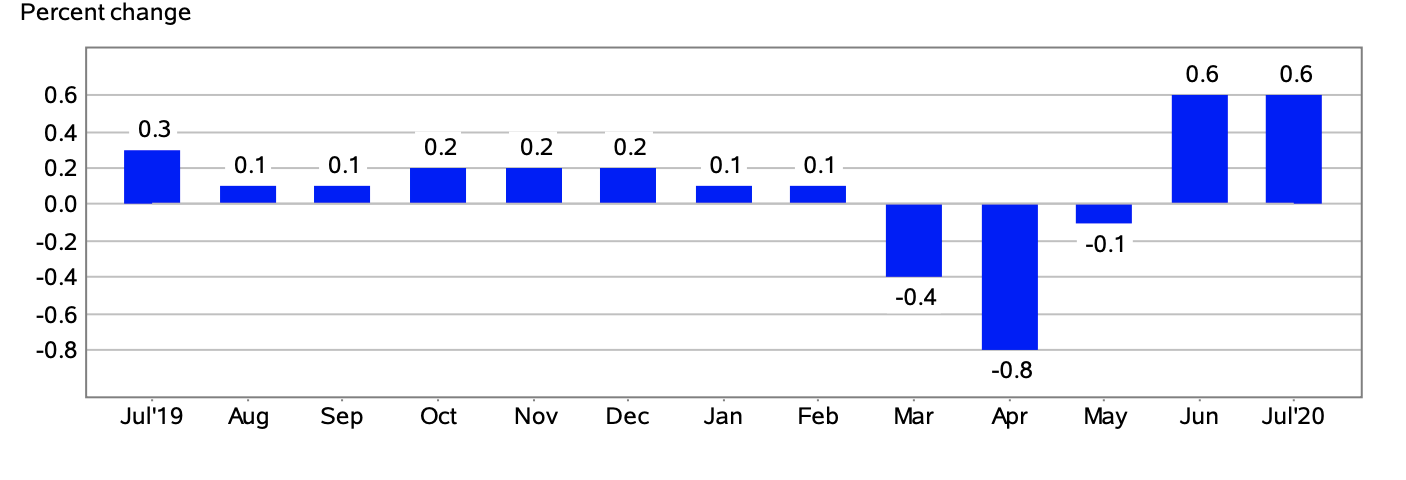
(Source: US Bureau of Labor Statistics)
Energy
In July, the index for energy increased by 2.5%, primarily because of the rise in gas prices. The gasoline index saw a 5.6% increase for the month, after a 12.3% rise in June, stated the US Bureau of Labor Statistics. The index for electricity edged up 0.3%, while conversely, the natural gas index dropped 1% for July.
Overall over the last 12-month period, energy index dropped 11.2%. Gasoline prices have plummeted 20.3%, as has the fuel oil index by 27.2% over the past year. Likewise, the natural gas index and electricity index both decreased by 0.3% and 0.1%, respectively.
Food Index
The food index dropped 0.4% in July, marking the first decrease since April 2019, reported the Bureau of Labor Statistics. The food at home index decreased 1.1%, with five of the six grocery indexes seeing percentage declines. “This decline was led by the index for beef, which fell 8.2 percent in July after increasing sharply in recent months,” stated the bureau.
Over the last 12-months, the index for food at home rose by 4.6%. The index for meats, poultry, fish, and eggs rose 8.4% since this time last year. The beef index witnessed the largest percentage increase with 14.2%.
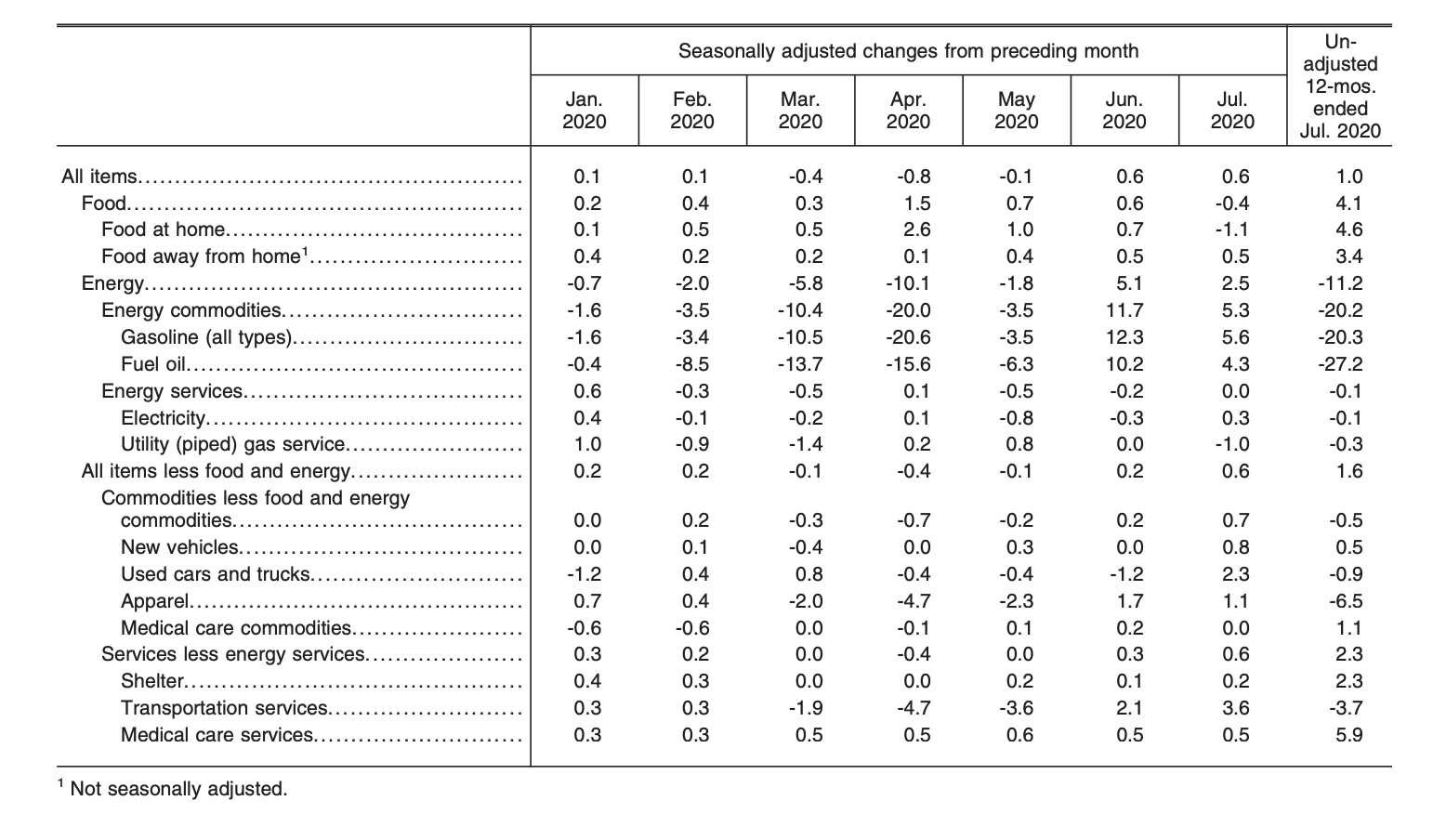
(Source: US Bureau of Labor Statistics)
All Items Less Food and Energy Index
In July, the all items less food and energy index edged up 0.6%. Component indexes all saw percentage increases for the month including motor vehicle insurance by 9.3%, the shelter index by 0.2%, and the rent index by 0.2%. In addition, the index for medical care increased by 0.4%, as did the indexes for physician services and hospital services, by 0.7% and 0.2%, respectively.
Over the past year, the all items less food and energy index increased 1.6%. The index for shelter edged up 2.3%, as did the rent index by 3.1% and the medical care index by 5%. Component indexes that saw major decreases were airline fares, apparel, motor vehicle insurance, and used cars and trucks, reported the US Bureau of Labor Statistics.
Source cited: https://www.bls.gov/news.release/archives/cpi_08122020.htm
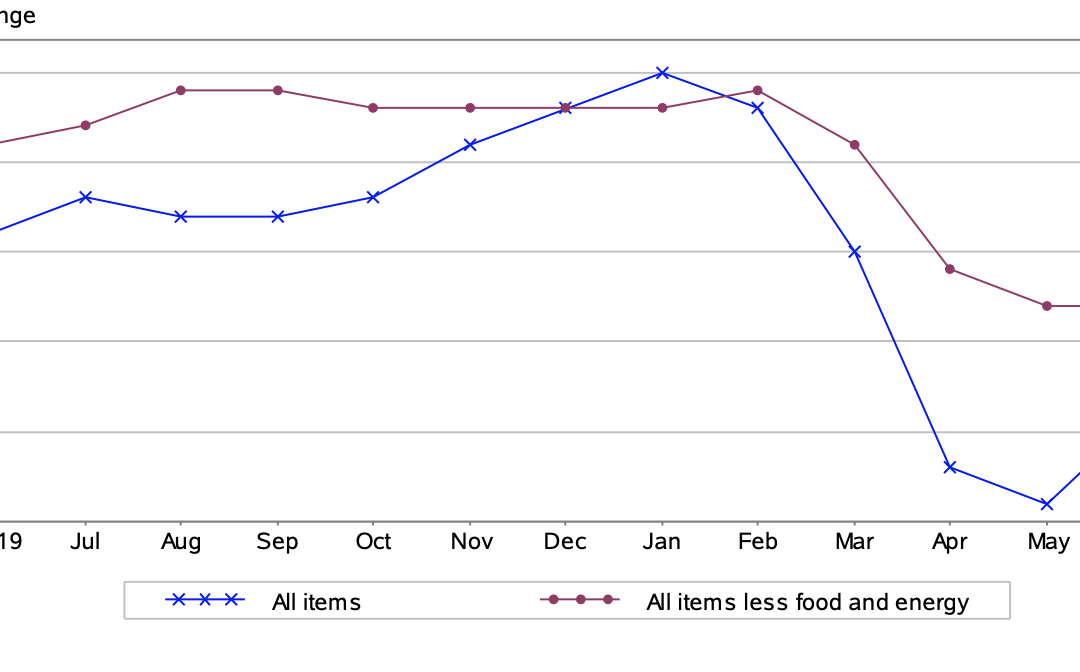
by Sarah Bauder | Jul 14, 2020 | CPI
The Consumer Price Index for All Urban Consumers (CPI-U) edged up 0.6% in June on a seasonally adjusted basis, reported the US Bureau of Labor Statistics. Previously, it had dropped by 0.1% in May.
Over the past year, before seasonal adjustment the all items index has risen 0.6%.
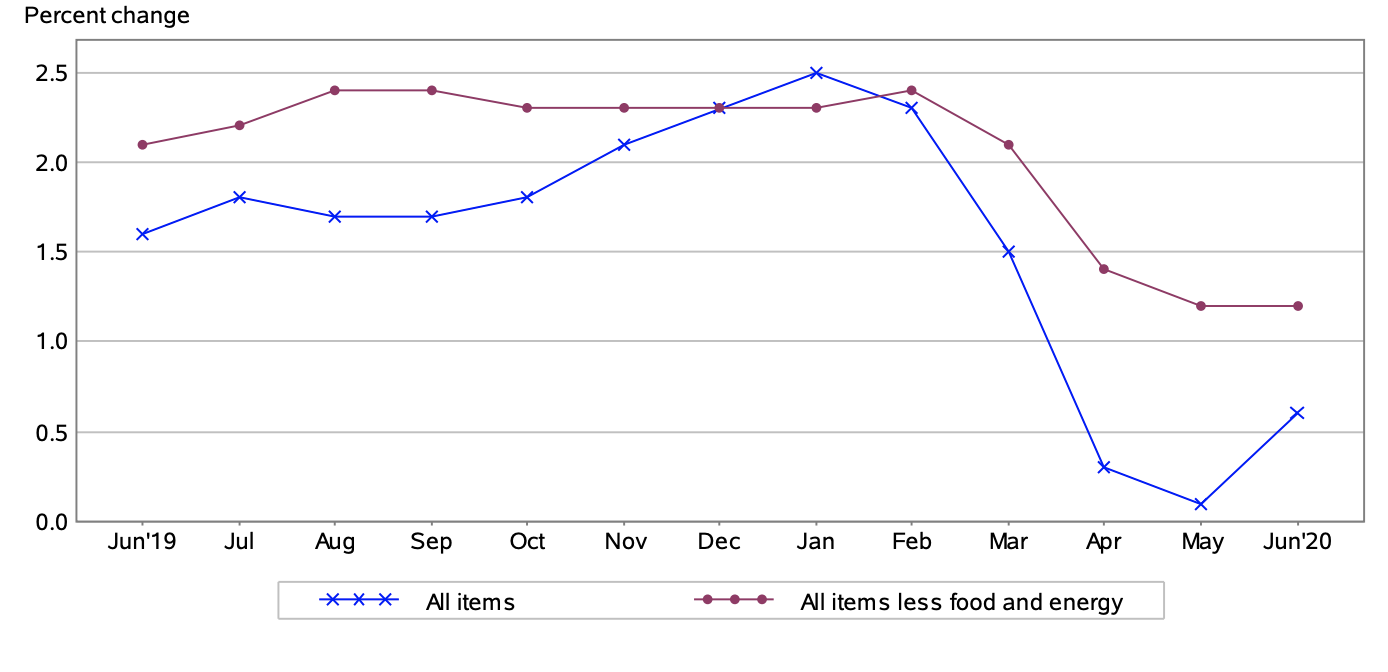
(Source: US Bureau of Labor Statistics)
Energy Index
The price of gasoline soared 12.3% in June, which “accounted for over half of the monthly increase in the seasonally adjusted all items index,” stated the bureau. The increase in the gasoline index contributed to the 5.1% rise in the energy index in June. Conversely, the index for electricity dropped 0.3% for the month.
Over the last 12-month period, the index for energy has declined by 12.6%. Gasoline prices have plummeted 23.4%, and likewise, the index for fuel oil plunged 29.9% over the past year.
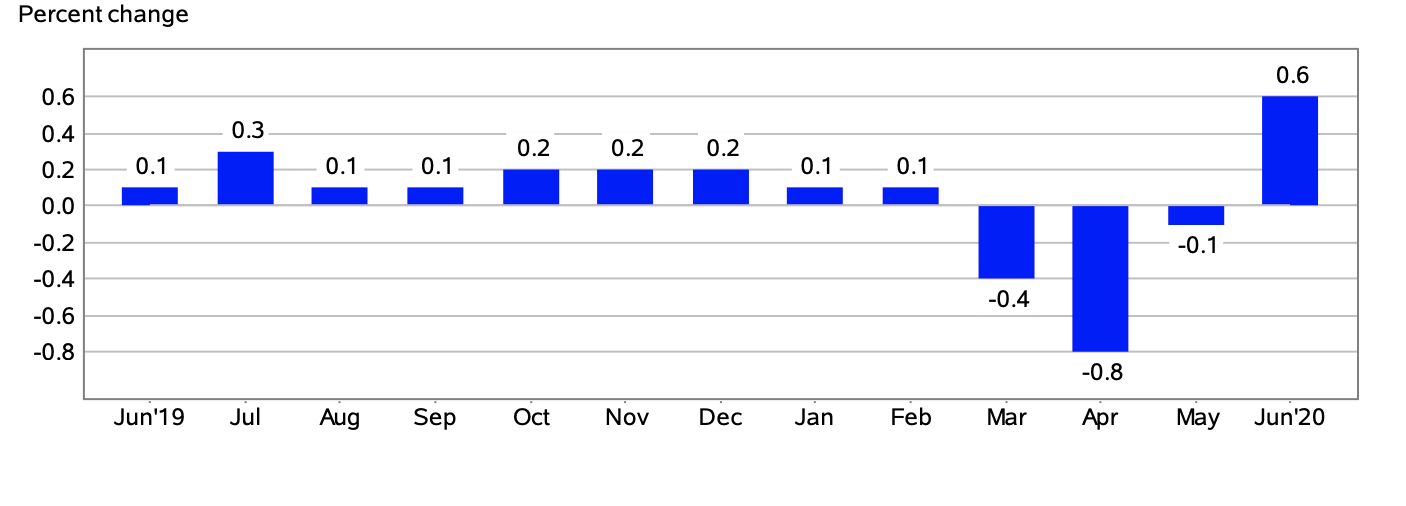
(Source: U.S. Bureau of Labor Statistics)
Food Index
In June, the index for food 0.6%. The bureau reported that for the month of June, five of the six grocery store food group indexes saw price rises – specifically, meat, poultry, fish, and eggs all edged up by 2%. The index for food away from home also increased by 0.5%.
Overall, the food at home index rose 5.6% over a 12-month period, marking the largest year-over-year percentage increase in the index since December 2011, stated the bureau. All six of the grocery store food group indexes increased over this period, with the price of beef specifically, soaring 25.1% since this time last year.
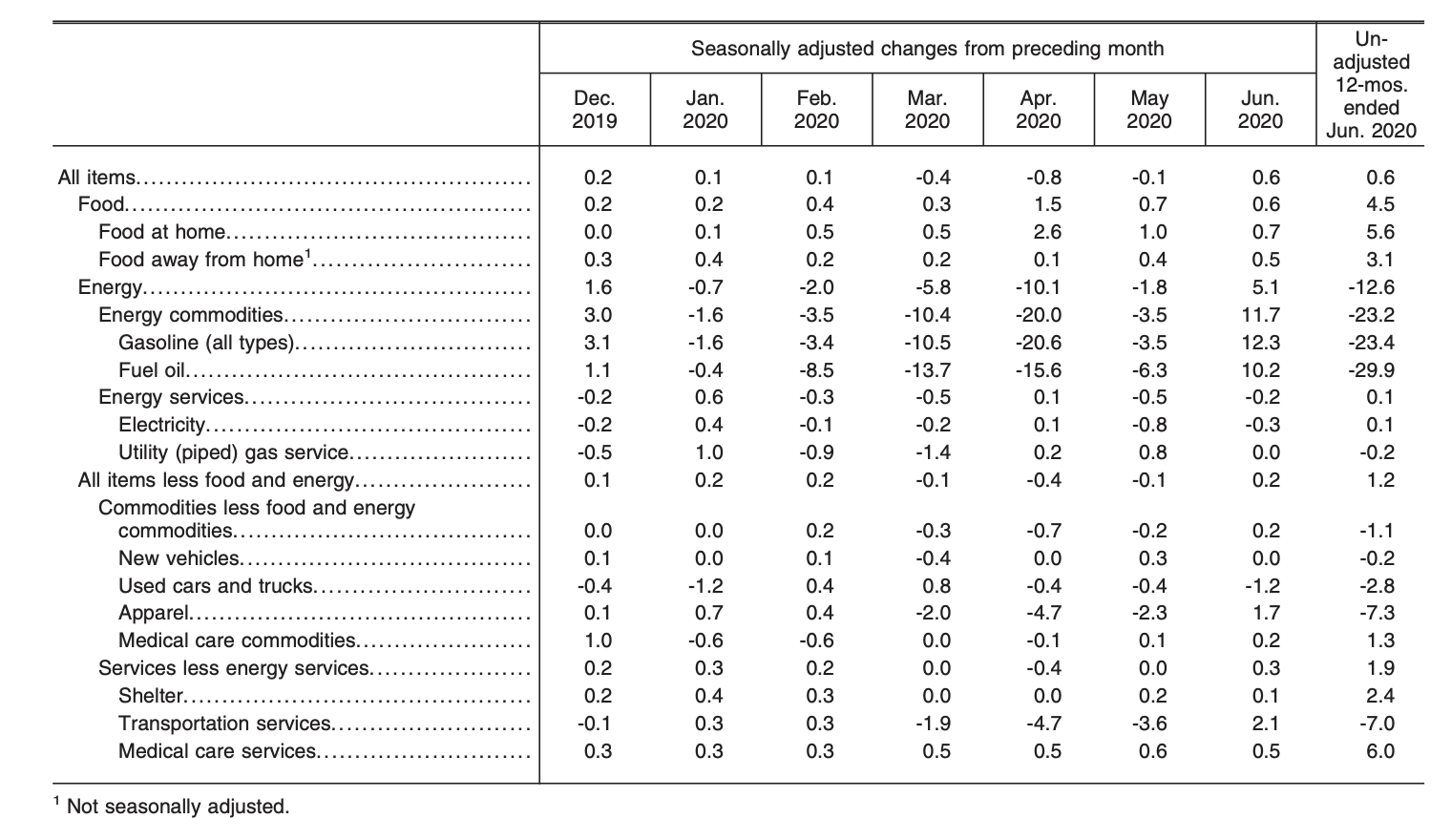
(Source: U.S. Bureau of Labor Statistics)
All Items Less Food and Energy Index
The all items less food and energy index rose 0.2% in June. The price of motor vehicle insurance rose by 5.1%. The index for shelter also increased by 0.1%, as did the index for medical care by 0.4%.
Over the last 12 months, all items less food and energy index increased by 1.2%. The shelter index edged up by 2.4%, as did the rent index by 3.2%. Additionally, the index for medical care also rose over the past 12 months by 5.1%.
The US Bureau of Labor Statistics released a statement pertaining to the COVID-19 pandemic:
“Data collection by personal visit for the Consumer Price Index (CPI) program has been suspended since March 16, 2020. When possible, data normally collected by personal visit were collected either online or by phone. Additionally, data collection in June was affected by the temporary closing or limited operations of certain types of establishments. These factors resulted in an increase in the number of prices considered temporarily unavailable and imputed. While the CPI program attempted to collect as much data as possible, many indexes are based on smaller amounts of collected prices than usual, and a small number of indexes that are normally published were not published this month.”
Source cited: https://www.bls.gov/news.release/archives/cpi_07142020.htm
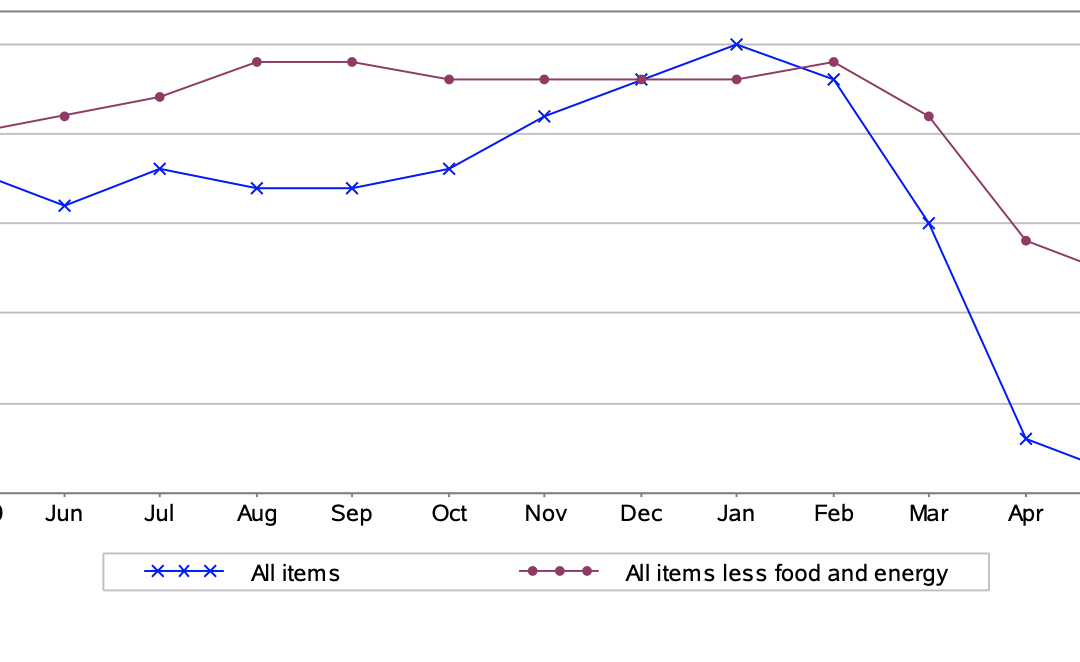
by Sarah Bauder | Jun 10, 2020 | CPI, Inflation
The Consumer Price Index for All Urban Consumers (CPI-U) dropped 0.1% in May, after plummeting 0.8% in April, reported the US Bureau of Labor Statistics. This percentage is on a seasonally adjusted basis.
The all items index has edged up 0.1% before seasonal adjustment, over the past year.

(Source: US Bureau of Labor Statistics)
Energy Index
The index for energy dropped 1.8% in May, after plunging 10.1% in April (which marked the steepest monthly decline for the index since November 2008). Gas prices dropped 3.5% in May, after plunging 20.6% in April. The index for electricity also decreased 0.8%, which was the largest one month drop since May 2015, stated the US Bureau of Labor Statistics. Conversely in May, the natural gas index increased by 0.8%.
Overall over the last 12-month period, the index for energy declined 18.9%, with all major energy indexes seeing significant decreases. Gas prices plunged33.8%, and the fuel oil index likewise plummeted 37.5%. In addition, the natural index fell 0.3%, and the electricity index dropped 0.2% over the past 12 months.
Food Index
In May, the food index rose by 0.7%. The increase was contributed to the 3.7% rise in the index for meats, poultry, fish, and eggs, stated the US Bureau of Labor Statistics. Additionally, the bureau reported that the beef index soared 10.8% in May, marking the largest monthly increase of the index since records have been kept.
Over the last 12 months, the food at home index has risen 4.8%. The index for meats, poultry, fish, and eggs rose 10% since this time last year. This marks the steepest 12-month rise in this index since May 2004, reported the bureau.
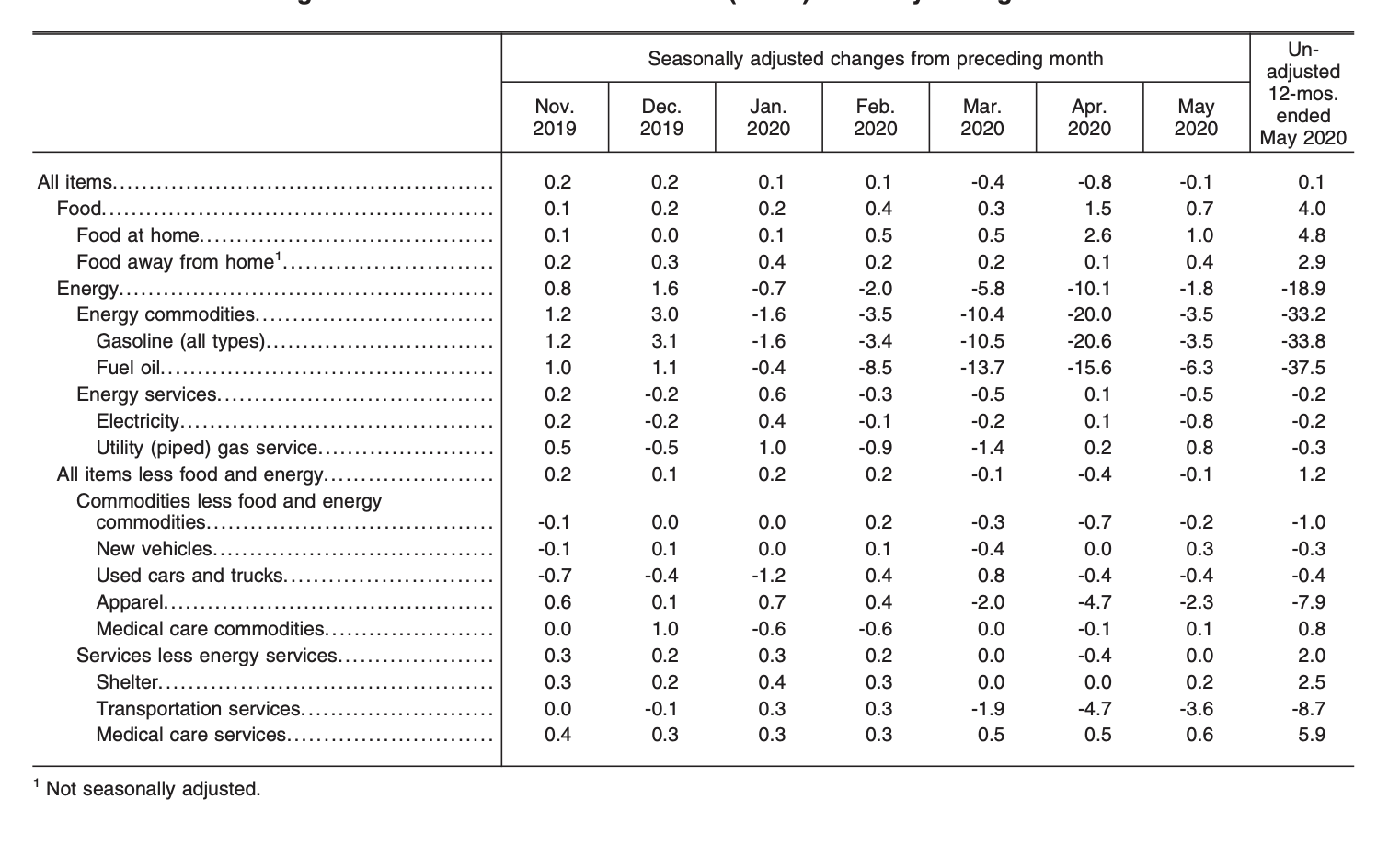
(Source: US Bureau of Labor Statistics)
All Items Less Food and Energy Index
In May, the all items less food and energy index dropped 0.1%. Component indexes all saw declined including motor vehicle insurance by 8.9%, the apparel index by 2.3%, and the airline fare index by 4.9%. Conversely, the shelter index increased by 0.2%, as did the medical care index by 0.5%.
Over the last 12-month period, the index for all items less food and energy increased by 1.2%. The index for shelter edged up 2.5%, as did the medical care index by 4.9%. Component indexes that saw major decreases were the airline fare index by 28.8% and motor vehicle insurance by 14.3%, reported the US Bureau of Labor Statistics.
Source cited: https://www.bls.gov/news.release/archives/cpi_06102020.htm
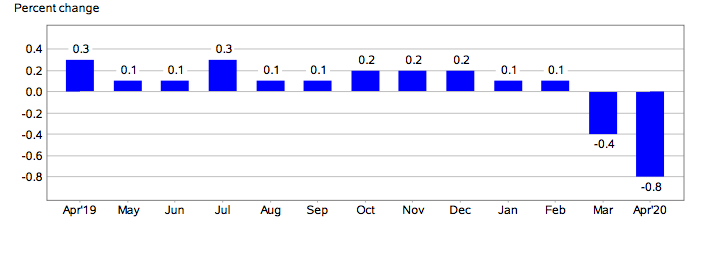
by Sarah Bauder | May 12, 2020 | CPI
The Consumer Price Index for All Urban Consumers (CPI-U) plummeted 0.8% in April, marking the largest monthly drop since December 2008, reported the US Bureau of Labor Statistics. This percentage is on a seasonally adjusted basis.
The all items index has risen 0.3% before seasonal adjustment, over the past year.

One-month percent change in CPI for All Urban Consumers (CPI-U), seasonally adjusted, Apr. 2019 – Apr. 2020 (Source: Bureau of Labor Statistics)
Energy
The index for energy plunged 10.1% in April, marking the largest monthly decline in the index since November 2008, stated the Bureau of Labor Statistics. Gas prices dropped a staggering 20.6% in April, and since December of last year have decreased 32.5%. Likewise, for the month of April, the fuel oil index also dropped 15.6%. Conversely, both indexes for electricity and natural gas rose 0.1% and 0.2%, respectively.
Over the last 12-month period, overall the energy index declined 17.7%, which was the largest percentage drop for the index since September 2015. In the last 12 months, the index for gasoline plummeted 32%, and the fuel oil index likewise plummeted 33.2%.
Food Index
In April, the food index rose 1.5%. Specifically, the food at home index leapt 2.6%. The Bureau of Labor Statistics reported that marked the largest monthly increase for this index since February 1974. The food away from home index also increased slightly by 0.1%.
Over the last year, the index for food at home has risen 4.1%. Additionally, the food away from home index has also risen 2.8% over a 12-month period.
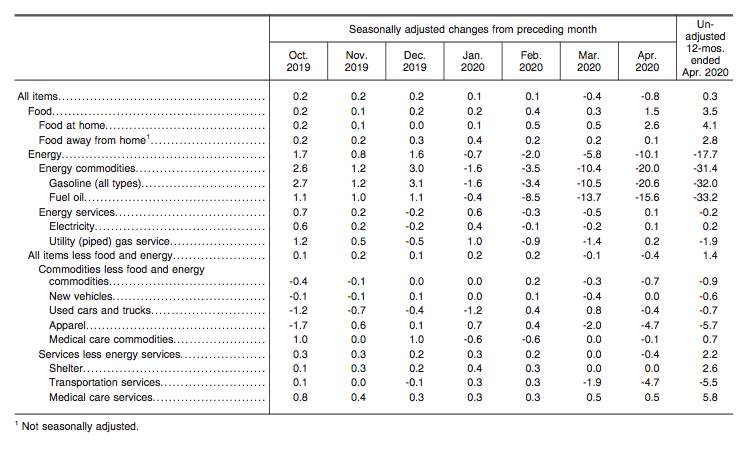
(Source: Bureau of Labor Statistics)
All Items Less Food and Energy Index
In April, all items less food and energy index for dropped 0.4%. The Bureau of Labor Statistics reported that this was the largest monthly decline since 1957 when records commenced being kept.
Over the 12-month period, the index for all items less food and energy increased 1.4%. The index for shelter increased 2.6% over the last year, as did the rent index to 3.5%.
The Bureau of Labor Statistics released a statement regarding CPI data for April 2020:
“Data collection by personal visit for the Consumer Price Index (CPI) program has been suspended since March 16, 2020. When possible, data normally collected by personal visit were collected either online or by phone. Additionally, data collection in April was affected by the temporary closing or limited operations of certain types of establishments. These factors resulted in an increase in the number of prices considered temporarily unavailable and imputed. While the CPI program attempted to collect as much data as possible, many indexes are based on smaller amounts of collected prices than usual, and a small number of indexes that are normally published were not published this month.”
Source cited: https://www.bls.gov/news.release/archives/cpi_05122020.htm
by Sarah Bauder | Mar 11, 2020 | CPI
The Consumer Price Index for All Urban Consumers (CPI-U) increased 0.1% in February, the US Bureau of Labor Statistics reported. This is the same percentage rise seen in January, on a seasonally adjusted basis. Increases in food prices and shelter offset the lower price of gasoline. The all items index has risen 2.3 % before seasonal adjustment, over the past year.
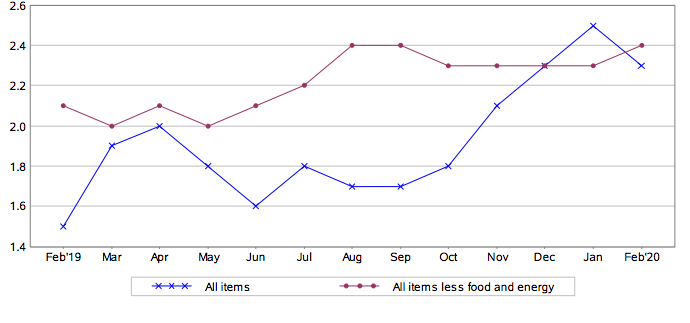
(Source: US Bureau of Labor Statistics)
Food Index
Increasing food prices were a contributing factor to the rise in the seasonally adjusted all items index. In February, the index for food edged up 0.4%. The food at home index increased 0.5%, marking its largest jump since May 2014, the bureau reported. Throughout the month, five of the six main grocery indexes saw price increases. The food away from home index also increased by 0.2% in February.
Over the last year, the index for food at home has risen 0.8%, with the dairy and related products index seeing the largest gain with 3.6%. Over the past 12-month period, the food away from home index increased by 3.0%.
All Items Less Food and Energy Index
In February, the all items less food and energy index edged up 0.2%. Both the indexes for shelter and rent rose 0.3%, respectively, with the index for owners’ equivalent rent rising by 0.2%. The index for medical care also saw a 0.1% increase over the month.
Over the last year, the all items less food and energy index increased by 2.4%. The shelter index gained 3.3% and the medical care index leaped 4.6% over the past 12-month period.
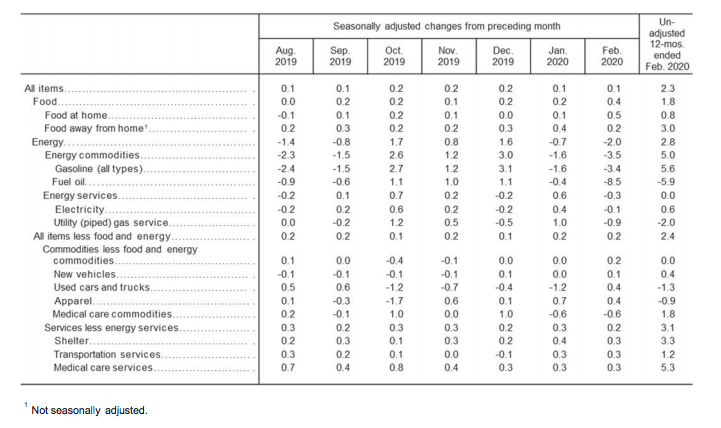
(Source: US Bureau of Labor Statistics)
Energy Index
In February the energy index dropped 2.0%, the bureau reported. The price of gasoline decreased by 3.4% over the month. The index for fuel oil declined 8.5%, with the indexes for natural gas and electricity also declining, 0.9% and 0.1%, respectively.
Over the last 12-month period, overall the energy index increased by 2.8%. Gasoline prices rose 5.6%, as did the index for electricity with a 0.6% rise. Yet, over the past year, the fuel oil index decreased by 5.9% and likewise, the natural gas index dropped 2.0%.
Source cited: https://www.bls.gov/news.release/archives/cpi_03112020.htm



















